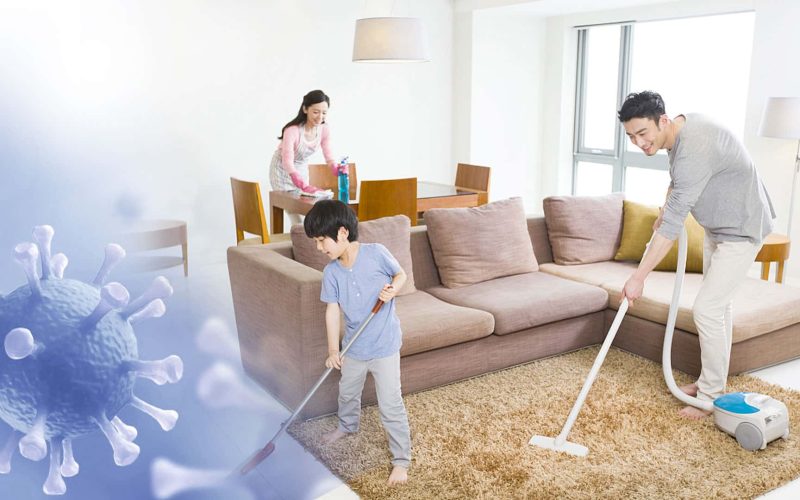Covid-19 is a virus that no one wants to be infected with for obvious reasons.
While recovery is the main goal for anyone who tests positive, the next priority is ensuring no one else gets infected.
Even after the end of isolation, your test showed that the worst is over and the symptoms are no longer present.
There is still this fear that the virus is lingering somewhere in your home, which is why this article on disinfecting your house after COVID-19 is important.
The virus that causes COVID-19 can land on surfaces. People can become infected if they then touch these surfaces and further touch their mouth, nose, or eyes.
According to the CDC, the risk of infection from just touching a surface is usually low in most situations.
The most effective and reliable way to prevent surface infection is to wash your hands regularly with water and soap or use an alcohol-based hand sanitizer.
Cleaning and then disinfecting surfaces can also minimize the risk of infection.
Additionally, recent studies have revealed that the novel coronavirus can stay in the air for up to three hours, live on surfaces like cardboard for up to 24 hours, and on stainless steel and plastic for up to three days.
But now that we are slowly returning to our normal life taking care of ourselves and our loved ones is still important.
We need to ensure we feel good enough to do what needs to be done without distractions or obstacles.
A lot has changed during the pandemic, but thorough house cleaning and disinfection, as well as the general knowledge of where the virus might have circulated and how to disinfect your house after COVID-19, is still crucial.
You can’t get rid of everything in a day or two. It’s essential to take one step at a time and do what it takes to keep your environment clean and safe.
If you recently had a case at home or have already passed the isolation phase of COVID-19, read below on how to disinfect your house after COVID-19.
What You Need to Know About Surface Viruses
According to experts, viruses, in many ways, are not alive outside of their hosts. “This means that viruses, novel coronaviruses or otherwise, do little to household items other than slowly decompose.
The virus may be present on the item, but the items themselves cannot be infected, and the virus cannot replicate or grow on any item in your home or elsewhere.
Over time, viruses on household surfaces break down, and certain factors can accelerate this process.
Generally, the longer you leave them, the higher the ambient temperature, or the lighter they are exposed to, the faster they break down. However, approved disinfectant chemicals may also work.
Clean Before Disinfection
After the disease runs its course, it is necessary to clean before disinfecting the room or rooms used by the patient and the objects with which he has been in contact.
Cleaning visibly dirtied surfaces, followed by disinfection, “is the best measure to prevent COVID-19 and other viral respiratory illnesses in the home and community,” the CDC says.
By the way, cleaning and disinfection are not the same:
- Cleaning involves removing germs, dirt, and impurities from surfaces. It does not kill germs but reduces the number of germs on surfaces.
- Disinfecting means using chemicals registered with the Environmental Protection Agency to destroy germs and viruses on surfaces. This is done after cleaning and can further reduce the risk of spreading infection.
If you can, the easiest way to secure a room after someone in your household has contracted COVID-19 is to lock it down for a week, says Colleen McLaughlin, associate professor of epidemiology at Albany College. of Pharmacy and Health Sciences in Albany, New York.
“If the room isn’t needed, just close the door for seven days,” she says. The virus will then be inactive. “The longer you wait, the safer it will be to clean.”
However, this is not always practical. If you cannot wait that long, immediately take the necessary precautions and clean and disinfect the area.
If possible, you can also contact special cleaning services and be sure to indicate the reason for the cleaning so that they can come prepared.
However, many products, such as soapy water and vinegar, can be used to clean hard surfaces.
While cleaning high-traffic surfaces to remove contaminants, dust, and debris is a necessary step in cleaning your home, you should still disinfect those surfaces from the novel coronavirus. That is why it is essential to know how to disinfect your house after COVID-19.
What Cleaning Products Kill the COVID-19?
It’s not just about knowing how to disinfect your house after COVID-19 but also about making sure the products you use are effective enough to do the job.
However, not all cleaning products are effective against germs, so you need to know which products kill COVID-19.
The EPA (Environmental Protection Agency) provides a comprehensive list of disinfectants that can kill the novel coronavirus.
You may already have some of these effective products at home, like:
- Disinfecting wipes, including Clorox, Lysol, or store-brand name wipes
- Disinfectant sprays, such as Purell, Clorox, or Lysol
- Isopropyl alcohol
- Hydrogen peroxide
While it’s essential to use effective anti-virus products, proper techniques for thorough surface disinfection are also important.
The EPA recommends leaving the product wet on surfaces or objects for 10 minutes, killing 99.9% of germs.
If you don’t have disinfectant products on hand and can’t find them in stores, the CDC also offers instructions on how to make a homemade bleach-based disinfectant spray.
If you decide to use this product, wear gloves, open windows, and be careful, as bleach can damage or discolor sensitive surfaces.
How to Disinfect Your House After COVID-19?
COVID-19 can be transmitted by close contact with respiratory droplets emitted by an infected person and by airborne viral aerosols, especially in poorly ventilated closed environments, such as an air-conditioned room.
People can also become infected if they touch their eyes, nose, or mouth after contact with surfaces infected with the virus.
The first step is to ensure that the room or area you are disinfecting is always properly ventilated.
Simple ventilation circulation can be achieved by opening windows and running a fan.
1. Focus on High Traffic Areas
You don’t need to clean your house from top to bottom each day, which is why we are here to guide you on disinfecting your house after COVID-19, but you should focus on disinfecting areas that are breeding grounds for germs.
If you or your family visit or spend most of the day in this area, you should start by disinfecting it.
This would include common areas such as the living room, kitchen, hallways, and bathrooms.
Start by using an aerosol disinfectant spray to kill any airborne particles. You can also hire a disinfection service, if possible. Then, clean the parts of the surface you come in contact with the most.
Examples of the most common important items to disinfect include:
- Handles/knobs for cabinets and drawers
- Faucets
- Kitchen and bathroom counters and tables
- The toilet, especially the seat and handle.
- Handles for refrigerator, dishwasher, oven, and microwave oven
- Game remotes and controllers
- Cell phones, tablets, and other mobile devices
- Computer keyboards and mice
- Door knobs/knobs
- Table surface and countertops
- Stair railings
- Switches/switch plates
If possible, wear disposable gloves during disinfecting and dispose of them afterward.
If you have reusable gloves, disinfect them when you’re done. And remember always to wash your hands.
2. Throw Away Potentially Contaminated Items
Most of these items would be in the bathrooms, especially if the COVID-positive member used T&B. It would be a good idea to throw out and replace any items used, such as toothbrushes, toothpaste, mouthwash, dental floss, toilet paper, etc.
Take out the trash and immediately put it in the outside container. As for reusable items like dishes, you can wash them as usual. For more measure, you can immerse them in boiling water.
3. Thoroughly Clean the Rooms
This is only required for rooms where a sick family member stayed in or has stayed. Remove all sheets, blankets, and pillowcases from the bed and wash them immediately with warm water and bleach (colorless bleach for colored fabrics).
Follow the instructions for those specific materials to clean soft surfaces, like carpets, rugs, and curtains. If applicable, wash them in the laundry at the maximum water temperature.
Linen, bedding, clothing, and other soft items that have been washed can still be cleaned this way. Do not shake dirty clothes, as this could spread the active coronavirus through the air.
Again, follow proper washing guidelines and use the hottest water possible. Ordinary laundry detergent is also suitable, as the combination of warm water, bleach, and detergent is enough to kill germs.
Steam pillows and mattresses to sanitize them. You can also vacuum them, if possible. Clean all devices that circulate air in the room, such as fans, air purifiers, and air conditioners. Finally, fumigate or disinfect the area with an aerosol disinfectant spray.
4. Don’t Forget Your Car
Knowing how to disinfect your house after COVID-19 is incomplete if you forget other important places, such as the car, that need to be disinfected.
However, if an infected person was in your home vehicle before the positive test, you should also consider this and disinfect it.
Roll down all windows to allow indoor air to circulate, and use a disinfectant spray to remove any remaining particles.
Then disinfect any surfaces touched, such as the steering wheel, console, and door handles. After initial disinfection, take it to a car wash for a thorough cleaning.
5. Use the Right Cleaning Products
Ordinary cleaning products may not work when disinfecting your house after COVID-19. For most viruses and infections, using bleach solutions on surfaces is best.
If you have strong bleach, dilute it with lukewarm water or follow the ECA product recommendations.
When using on surfaces, ensure adequate ventilation to avoid burning your eyes or experiencing breathing difficulties.
After using the bleach solution or disinfectants, you can wipe off the residue with a damp towel. It is also recommended that you wear gloves (and even goggles) when disinfecting any area.
Finally, discard or thoroughly wash the towels and sponges you used to clean and disinfect the area.
6. Don’t Skip the Waiting Step
Disinfection is not instantaneous. Always follow the manufacturer’s instructions, especially when leaving the product on the surface before cleaning it.
Read the label to determine how long the surface should stay wet. Some might say it needs to be wet for a few minutes.
For a 5% sodium hypochlorite solution, which is most household bleaches, you should leave it on the surface for 10 minutes before wiping it off. So ensure you don’t skip any steps to disinfect your house after COVID-19.
If you use a spray bottle, leave it on for a few minutes before wiping it off. If you use wet wipes, do not use them once they are dry, as they are no longer effective.
You want to see a wet surface and stay wet for a while. Note that if you don’t give your disinfectant enough time to do its job, you’re not disinfecting.
Keep in mind: Even after proper disinfection, if a member of your household tests positive for COVID-19, the best way to prevent the spread is for all household members to wear proper face masks.
7. Keep Washing Your Hands
It would be a bad idea to follow all of these instructions on disinfecting your house after COVID-19 and still not have very clean hands.
Yes, it’s been said countless times, but that’s because it’s the most important and easiest way to spread and contract viruses: whatever you choose to do, the best way to reduce the risk that the virus does not re-enter your home or getting it from someone or external surface is to wash your hands.
The CDC recommends vigorous washing with soap and water for 20 seconds that extends beyond the hands to the wrists, between the fingers, and under the fingernails.








